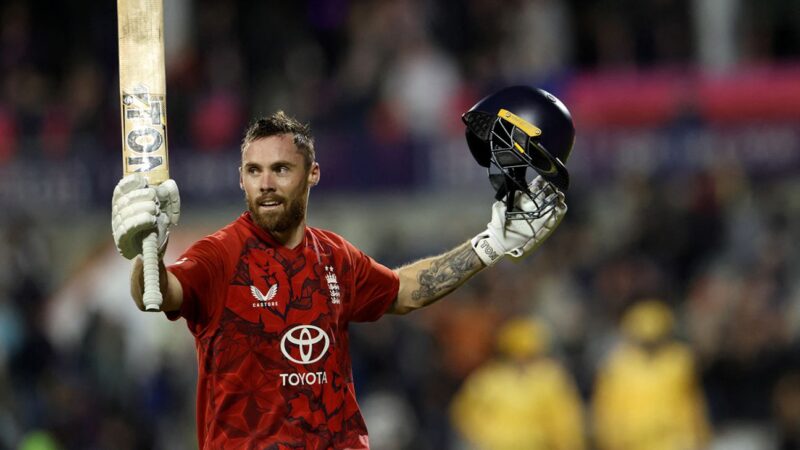Phil Salt is a man who cares about detail. Nobody has scored as many runs as quickly, either in the IPL or in an England T20 shirt, but his outwardly daring approach is underpinned by diligent preparation. He views the popular perception that his approach boils down to ‘see ball, hit ball’ as a misapprehension, and one that has started to become grating.
“I saw something the other day that summed it up quite well: ‘We are quite suspicious of the shortest format in this country.’ I don’t know why that is, but sometimes it can be viewed with a bit of a hit-and-giggle mentality,” Salt says, stirring a flat white and reflecting on a year which has cemented his status as one of the world’s premier T20 openers. “It really isn’t, is it?”
Test cricket still reigns supreme in England, but Salt has not reached the point he has by treating T20 as an afterthought. He can be a fiery character on the field and describes himself as fiercely competitive, yet spends hours preparing for each game by studying footage and analysis with a notebook to hand. “Everything’s got to have due process behind it,” he explains.
“It really is down to you… I’ll get my iPad and have a look through the footage. More often than not, I’ll grab someone who I know [to discuss it with] and then I’ll go through the footage myself too, just with my notebook, and write down what I think is important in that moment. I’ll then go away from it for a bit, and come back and have another look at it.”
Salt requests bowlers’ pitch-maps to work out where they concede their runs, and tries to work out how they sequence their overs: “Where they go in the first few balls, that’s a massive tell. You’ve got to look at the whole picture: where they feel most comfortable going at the death, what their pace-off variations are, and when they bowl them. What does a bowler go to straight after he’s been hit for a boundary?
“It also looks different if you compare venues. On a wicket like Cardiff, where there’s a bit in it for the bowlers, there’s no use looking at what they did when the ball was flying in Mumbai because it’s not relevant. You have to really zone in on some guys… You can only know that by drilling into the analysis and what they’ve done in the past.”
There is also a predictive element to Salt’s preparation: “Even the smaller stuff, like watching the opposition in the warm-up, you get a massive tell for where people are, and what they’re feeling most comfortable with on that day. When you see someone bowling five or six yorkers before a game, that could be someone you’re lining up at the death.
“It’s constantly a moving picture but it’s all about trying to get as much information in as possible, without clouding your own mindset, and just remember that regardless, they could bowl anything at you. But you’ve got to be on top of your game to react to it… The end goal is that I want to know exactly where the opposition’s at, at all times.”
Salt has been England’s standout player in their short block of end-of-season T20 cricket. The last two weeks have brought him 259 runs off 130 balls against South Africa and Ireland, including a career-best 141 not out in England’s record total of 304 for 2 on his home ground at Old Trafford; he has now scored four of England’s eight T20I hundreds.
But he pushes back against the idea that this month has been a purple patch, and with some justification. Over the past two years, he has averaged 47.66 in T20Is with a strike rate of 176.27, outscoring all of his England team-mates; he has also become an IPL regular, winning back-to-back titles for two different franchises.
“I feel like this is the player that I want to be, but I feel like I’ve still got improvements to make in so many areas,” Salt says. “I’m turning up approaching every game with the same mentality: I want to be there, I want to contribute, I want to be the man. That’s the mindset I have. And also, I want to enjoy it… When I do that, that’s when I play my best.”
His T20 form has not translated into 50-over cricket, and he has not featured in England’s ODI set-up since March: “I did my best in that role,” he reflected last week. “It didn’t quite work out.” But there is an unintended consequence: rather than tinkering with his approach across formats, Salt can pour his full focus into T20 ahead of February’s World Cup.
It was not long ago that his place appeared uncertain, at least outwardly. In June, Salt missed England’s T20 series against West Indies on paternity leave, with Ben Duckett and Jamie Smith opening together in his absence. Their success together, reprising their 50-over partnership, led to speculation that they would continue in those roles indefinitely.
Salt paid it little attention, with his focus instead on becoming a father. His son arrived early, and the postponement of the IPL’s final weeks prompted an unexpected clash. “I was in Ahmedabad two days before the final, and got a phone call off the missus to say it was definitely happening,” he recalls. “I got on the plane as quickly as I could.”
His son was born on June 1, and he was back on a plane the next day. “Abi kicked me out the door, basically,” he says, laughing. “She said, ‘You have to play’. She made the decision for me, which was very funny – and very selfless of her.” Two days later, he scored 16 from nine balls and took a brilliant catch to help Royal Challengers Bengaluru to their first title.
“I missed an IPL final the year before, and that one really hurt because we [Kolkata Knight Riders] went on to win it. I was part of everything leading in, and then to not be a part of it did sting a bit… The final was a little bit of a blur, until the last over, which I remember second by second. It all happened very quick… It was really, really special.”
Fatherhood marks a new phase in his life off the field but, at 29, Salt is approaching his prime on it. “He’s added more and more to his game,” Jos Buttler, his England opening partner, said last week. “He’s got a thirst for knowledge… His off-side play is outstanding, and when he’s so strong through the leg side and you’ve only got two fielders out, he’s hard to stop.”
Salt has made a minor technical change, holding his bat higher and opening the bat face slightly to access the off side, but says the biggest change has been in his mindset: “It was particularly to have, from third, fourth, fifth and sixth stump, four different areas that I can hit those balls. That is primarily where you’re going to face most balls against the new ball.
“When you’re playing that area well and also hammering the short ball at the same time, two fielders [out of the ring] shouldn’t be enough… It’s been about developing my scoring areas. For example, when someone does throw two [deep fielders] out leg-side, I’ve still got 80 yards there where I can score a boundary at a really low risk.
“That’s probably the biggest difference,” Salt says, comparing himself to a younger version of himself. “That player might have gone, ‘I’ll just hit it over them’. But if I can hit that same ball over 45 [short fine leg] or if I can just change the position I’m standing on the crease and hit it through mid-on, it feels like a completely different game for me and for the bowler.”
The growing sense that detailed analysis and planning has fallen out of fashion in English cricket was underlined when Harry Brook described team meetings as “the most overrated things ever” earlier this month. But Salt’s success should demonstrate the enduring value of preparation. As he puts it: “I don’t want there to be any surprises.”








